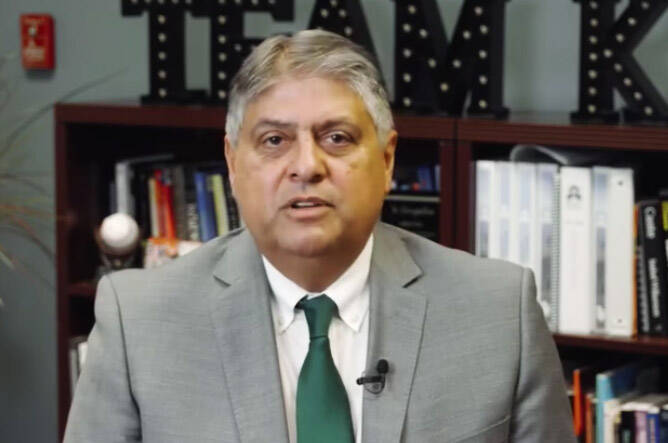With enrollment down about 2,100 students from 2018 and the loss next year of federal funds, Kent School District superintendent Israel Vela says reductions are ahead.
Vela sent an email to district staff as they head off to winter break and posted a video on the district’s Facebook page telling people about the budget challenges ahead.
“Over the past year, I have openly communicated the budget challenges facing Kent School District (KSD) and other school districts in our region,” Vela said in the Dec. 14 email. “Declining enrollment, expiring federal funding, and inflationary cost pressures have contributed to these budget challenges.”
Vela didn’t list any specific budget deficit number or potential cuts, but those are expected to be revealed by district financial staff when they present the 2024-2025 budget proposal to the Kent School Board early next year.
Elsewhere, Seattle Public Schools board members on Dec. 13 approved a fiscal stabilization plan to address a projected $105 million deficit in the 2024-2025 school year, according to the Seattle Times. The district’s enrollment has dropped by almost 5,000 students since the 2019-2020 school year, which has resulted in an $81 million decrease in state money.
With a Kent student enrollment drop of 1,329 this year compared to projections, district staff expects less state revenue starting next year, according to an October 2023 financial report released at the Dec. 13 Kent School Board meeting. The board did not discuss the document at the meeting.
“Note that the state pays apportionment based on a prior projected student enrollment until January, when it will true up the apportionment to actual average student enrollment,” according to the report. “When this occurs, the district’s current gain in state apportionment will likely diminish significantly, as the state is paying on a prior projected enrollment 25,266 FTE (full time equivalent) until January, but the district’s current, actual average student enrollment is only 23,937 FTE.
“In the end, the district may only gain additional apportionment revenue of a little over $1 million for the year.”
That’s a big difference compared to how state general purpose fund revenue to the district increased to $46.5 million in October 2023 from $44.8 million in October 2022, according to the report.
“State apportionment has increased compared with last year, and explains the current increase of state general purpose revenue of approximately $1.7 million between October 2022 and October 2023,” according to the report. “The state is providing an additional $252 per student FTE for this year.”
Expenses, however, also are up.
Year to date expenditures and other financing uses for October 2023 are approximately $84.2 million, which is about $5.5 million or 7% higher than October 2022, according to the report. Salaries are up by about $5 million from a year ago.
The district’s fund balance remains solid as it sits at $78.1 million, according to the report. Over the last three years, that balance has been as high as $82 million in April 2023 and as low as $41.6 million in January 2022.
Due to COVID-19, the federal government provided funds to school district across the nation, including about $99 million to the Kent School District. The district has spent about $67.5 million of those funds, according to the October financial report.
“The federal Elementary and Secondary School Emergency Relief (ESSER) funding provided during the COVID-19 pandemic created an important source of financial stability when in-person instruction was suspended,” Vela said. “Federal and state officials hoped that enrollment declines would eventually return to pre-pandemic levels.”
In his email and video, Vela thanked voters for passing in November Proposition No. 1, the Replacement of Expiring Educational Programs and Operations Levy. That will fund about 15% of the general fund, including monies for athletics, music and arts, which are not funded by the state. The levy also will fund special education, advanced learning programs and multilingual education.
But Vela said that’s not enough.
“This funding continues the local levy support we have relied upon in the past; however, it does not address our current budget needs,” Vela said. “The failure of the Capital & Technology Levy is also a factor as we plan for the future.”
Voters turned down the Capital and Tech measure on the Nov. 7 ballot. It would have funded the district’s 1-to-1 laptop program, which provides a laptop to each student in the district, and paid to modernize safety systems, including intrusion and fire alarms. Monies also would have been used to upgrade HVAC systems, roof and boiler replacements, installation of synthetic fields at high schools, new flooring, paint and expand the preschool program to each elementary school.
Vela hopes the Legislature will provide more school funding during its 60-day session that starts in January, but isn’t counting on it to be enough.
“While I hope the state will provide more funding, it is unlikely that our district will receive enough funding to fully address our students’ needs,” Vela said. “With this in mind, I am communicating from a place of transparency, with a commitment to long-term financial stability.”
Vela said changes to the budget and staffing are ahead.
”Last spring, I shared our multi-year ‘stair-step’ approach to addressing budget needs, and the first steps were taken to adjust staffing and departmental budgets,” he said. “As we look to the future, we are considering ways to implement a larger reduction, along with re-alignment of the central administrative communities and teams to support our Strategic Plan.”
Talk to us
Please share your story tips by emailing editor@kentreporter.com.
To share your opinion for publication, submit a letter through our website https://www.kentreporter.com/submit-letter/. Include your name, address and daytime phone number. (We’ll only publish your name and hometown.) Please keep letters to 300 words or less.

